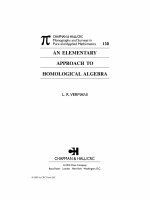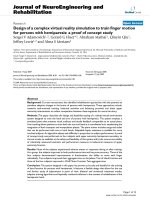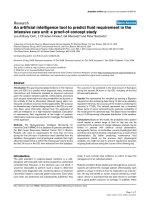An Evolutionary Approach to Standard Cell Synthesis from Behavioral Descriptions A proof of concept
Bạn đang xem bản rút gọn của tài liệu. Xem và tải ngay bản đầy đủ của tài liệu tại đây (479.24 KB, 7 trang )
An Evolutionary Approach to Standard Cell Synthesis from Behavioral
Descriptions: A proof of concept
Anil Bahuman
Benjamin Bishop
Khaled Rasheed
Artificial Intelligence Center
University of Georgia
Athens, GA 30602
Dept. of Computer Science
University of Georgia
Athens, GA 30602
Dept. of Computer Science
University of Georgia
Athens, GA 30602
Abstract
Standard cell design is a challenging task faced by
VLSI chip designers. Traditional methods of standard
cell design automation rely on a schematic
representation supplied by a design engineer. We have
demonstrated the possibility of applying a modified
genetic algorithm (GADO) to design a cell given only a
behavioral description (truth table). A working
inverter is designed as a proof of concept.
1
INTRODUCTION
The complexity of engineering design has acquired levels
that baffle individual human minds. There is a cry for
heuristic automation methods that can suggest designs
allowing human designers to add only the final touches. An
example of the need for design automation techniques is the
design of integrated circuits. The field poses one of the
toughest challenges to the evolutionary computation
community (and others interested in design optimization)
since large-scale, coupled, optimization problems commonly
arise. Mazumder and Rudnick [12] provide a good survey of
problems faced by the VLSI community and demonstrate
some genetic algorithm based solutions.
We demonstrate the possibility of one such tool that can
assist engineers to build standard cells (the lowest level of
logic where a designer is working at the transistor level;
designers use them as building blocks to synthesize higher
level logic functions) on-the-fly customized to ad-hoc
constraints that they need to address in their design. Our
method is an example of design by evolution by the use of
genetic algorithms.
Standard cell methodology is widely used in IC design.
Considerable effort [1,11,12] has been invested in attempting
to automate the design of a standard cell. Automation of
standard cell layout generation (1) significantly improves
turnaround time for creating new standard cell libraries, (2)
provides a test bed for evaluating new process technologies
by rapidly synthesizing cells and (3) enables rapid migration
of designs to new process technologies.
Most existing methods for cell synthesis start with a
schematic specifying how all transistors are connected
(netlist) and automate the processes of (1) placing the
transistors (placement), followed by (2) figuring out the
connecting wires between transistor terminals (routing) and
finally (3) minimizing the area occupied by the circuit
(compaction). Our implementation combines all these three
steps and attempts to evolve circuits on-the-fly given only a
behavioral (truth-table like) description.
The input specification consists of: (labels and cell templates
are defined in Section 2.2)
1.
A truth table description of the input and output with as
many possible transitions (more on this in 1.2).
2.
A set of building blocks consisting of geometries of
objects such as transistors, piece of polysilicon, piece of
polycontact etc (see Figure 2).
3.
A classification of labels used (as inputs and outputs).
4.
A cell template specifying the placement of fixed ports
(if any).
A design rule checker (MAGIC) and circuit simulator
(SPICE) are also used by the genetic algorithm to evaluate
and validate designs.
MAGIC [11] is one of the layout editors used by designers to
create cells. Figure 3 is a snapshot of a cell design as it
appears in MAGIC. It is essentially a smart tool that allows
the designer to place colored polygons that represent
physical layers that form the complex circuitry on a chip.
The tool is aware of the electrical characteristics of the
materials and has been programmed with a set of design rules
for a given technology. Design rules are constraints on the
placement and shapes of polygons that reflect the practical
constraints (such as tolerance levels) that the foundry - which
eventually etches the electronic copy of the design onto
silicon - has to deal with.
SPICE[18] is a circuit simulation tool that can take a layout
extracted from MAGIC and check to see if the circuit is
behaving as intended and also conduct analyses of various
performance parameters such as circuit delay, power
dissipation etc.
2
The genetic algorithm uses these external simulators to
evaluate its designs and attach the final fitness value to a
candidate design.
2.1
1.1
OUR RESEARCH GOAL
Given the goal of automating phases 1, 2 and 3 above into a
single phase, we set out to explore the possibility of
accomplishing this for a very simple standard cell - the
CMOS inverter – without a schematic and without
incorporating any design heuristics for transistor sizing,
splitting, ordering, placement, routing or compaction. The
tools we decided to work with were MAGIC – a layout
schematic editor, SPICE – a circuit simulator and a modified
version of GADO [4] – a design optimization engine
(Section 2.1).
Our goal was to start from a behavioral description for an
inverter, an optimization criterion and a set of building
blocks (different types/clusters of transistors, piece of “poly”,
piece of “metal1”, piece of “ndcontact” etc.) and attempt to
automate the process of finding a working inverter optimized
for the given criterion as a proof of concept.
The behavioral description consisted of a truth table of inputs
and outputs with all possible input transitions (0 to 1 and 1 to
0). This is because certain designs may fail on some
transitions. Table 1 lists all the input transitions used for the
inverter with corresponding outputs.
INPUT
OUTPUT
0
1
1
0
0
1
Table 1
But what about testing different input sequences? There are
an infinite number of input sequences and it is possible that a
design with unnecessary states fails at a certain input
sequence. Our own experience with this algorithm is that it
tends to find the simplest design and hence the correct
design. This is because complicated designs that have more
components also occupy more area and hence receive higher
penalties than simple designs. (The penalty scheme used in
the fitness function is discussed in 2.3).
AN EVOLUTIONARY APPROACH
GENETIC ALGORITHMS FOR DESIGN
OPTIMIZATION
Genetic Algorithms (GAs) are a class of heuristic algorithms
that can search for a solution by a process similar to natural
selection i.e. the desired characteristics of the solution are
enhanced by continued breeding.
We use GADO, which is a steady state Genetic Algorithm for
Design Optimization tool developed by Khaled Rasheed for
his PhD dissertation [4], for applications in engineering
design optimization where search spaces are very difficult to
search and evaluating fitness using external simulators can be
quite time consuming.
GADO maintains a population of potential designs (standard
cell designs in our case). The design of the schematic and
the optimization of the layout happen in parallel at both
logical (schematic/connectivity) and physical (layout) levels
as opposed to traditional methods.
2.2
REPRESENTATION
We use integers to encode a layout. Each design is
represented in the algorithm as a string (Figure 1) of Objects
corresponding to each component in the physical layout:
Orientatio
Object Type
Stretch
n
X
Y
Figure 1
An object is a member of a pre-defined set of building blocks
including various types of transistors, piece of polysilicon,
piece of ploycontact etc. Figure 2 is a snapshot of a MAGIC
file with all the blocks placed in a single file.
Another question that needs to be addressed is the
justification for using a behavioral description as opposed to
the traditional schematic description. We believe that this
added degree of freedom creates more room for innovation.
The algorithm simultaneously searches for the optimal layout
as well as the optimal schematic.
Figure 2
It may be noted that there are 15 object types that consist of
symmetrical and asymmetrical transistors of different types
(single, dual and triple). Three other blocks are pieces of
polysilicon, polycontact and “metal1” (extreme right, top to
bottom in Figure 2). The user may easily add other building
blocks as and when required.
Each object is further defined by its type, X and Y
coordinates, stretch and orientation (Figure 1). Cell limits
refer to the size of the grid of the maximum allowable cell
size (as defined by the user). This forces the GA to place
components only within the grid.
The orientation refers to a number (0, 1, 2 or 3) that decides
the rotation applied to a block (0, 180, 90 or 270 degrees
respectively).
The stretch factor is a number corresponding to the number
of units by which a block is scaled. The scaling is evenly
distributed along the direction of orientation. The maximum
scale is limited by the maximum allowable cell size
X and Y refer to the coordinates of the center of the object
and are thus also constrained to be within the maximum
allowable cell area.
depending on their importance. This way the GA fixes the
most serious violations first and progresses to make smaller
fixes.
In the first phase the GA tries to weed out incorrect designs
such as those with overlapping transistors. After succeeding
in that venture it goes on to check connectivity of individual
transistors and tries to encourage connections (more details
ahead). Simultaneously, the design rule checker is invoked
so that the GA tries to minimize both design rule violations
as well as broken connections.
After the GA has succeeded in creating designs with no
broken connections it passes on to the next phase where the
design rule check is made in conjunction with a circuit
simulation. In this stage, the GA is trying to simultaneously
satisfy the requirements of zero design errors and zero
simulation errors.
Once the GA has come up with a working circuit it
proceeds to optimize the design for a given criterion (i.e.
search in the space of correct designs), which could be
minimizing area, delay or power dissipation.
One of the most challenging aspects of the project was
developing, what the transistor connectivity check
component that encourages broken connections.
A directed graph was used to capture connectivity
information.
To illustrate the concept of nodes and
connections here is an example of a circuit layout abutted by
the graph used to capture connectivity information:
Figure 3
PARAMETER
VALUE
Fig 3 (a)
Fig 3 (b)
Object Type
1-15
11
11
Orientation
0-3
0
2
Stretch Factor
Cell limits
0
5
X
Cell limits
0
15
Y
Cell limits
0
14
Table 2
Table 2 summarizes the parameters of each object (column
1), the range of values that they may have (column 2) and
illustrates the values corresponding to the objects shown in
figures 3 (a) and (b). Note the effects of moving, stretching
and rotating the same object. Figure 3 also demonstrates the
use of templates. The 3 pieces of metal and the 4 labels
(Vdd, Gnd, in and out) are part of a user-defined template
over which the other objects are superimposed.
2.3
FITNESS FUNCTION
The fitness function checks a candidate design against a list
of constraints and penalizes it for every violation
encountered. The penalty values vary for each constraint
Figure 4
The graph is used to penalize nodes that do not influence
nodes that they ought to.
We also need to formally define influence (arrows in the
graph). Node A influences node B if there is (1) a direct
electrical connection, or (2) a uni-directional electrical
influence such as the control of the gate over the source and
drain of a transistor. In Figure 5, nodes 1 and 2 influence
one another by property (1); the bi-directional nature of
influence in represented by solid lines. Also nodes 3 and 4
exhibit property (2); an arrow going from node 4 to node 3
represents the unidirectional nature of influence.
It may be also noted that all labels were classified as inputs
or outputs. Vdd and Gnd were treated as inputs.
The rules that the influence check tests are:
1.
None of the labels should be shorted
2.
Every input must influence at least one output
3.
Every output must be influenced by at least one input
4.
Every transistor gate must be influenced by at least one
input
5.
Both source/drain terminals of a transistor must be
influenced by at least one input or influence at least one
output
designs that are very similar in order to encourage diversity
in the population of potential designs. This helps the GA
maintain a much more thorough representation of the search
space as well as allowing it to escape from local optima.
In the earlier runs, while the fitness function was under
construction a simple diversity function based on the
Euclidean distance between 2 strings was used. An example
with 2 hypothetical strings of 4 alleles (numbers in the
string) each illustrates the idea:
e.g. If the 2 individuals are A and B:
A:
11
B:
9
3 0
3
1
1 0
Thus the layout in Figure 4 violates rules 2 and 4 above as
may be seen in the graph.
The 4-dimensional Euclidean distance is calculated as the
square root of Σ (Ai – Bi) 2 where i =1 to 4.
Let us consider another case where there is a violation, say in
rule 3 above (not shown in figures). It is more useful to
know how bad the violation is than a binary yes/no. This is
accomplished by a distance check function that in case of a
violation in rule 3 will do a breadth-first graph traversal
starting from the floating output to determine all the nodes
that may influence it creating an O-list. Similarly another
graph traversal is made from each input to create their
respective I-list of nodes that they influence. Once created,
the distance function finds the shortest Manhattan distance
between nodes in the I-lists and the node in the O-list and
returns a penalty based on this distance. Note that many of
these nodes may be in different layers. We use a look up
table with values preset by a domain expert to calculate
distances between nodes in different layers.
= √ (11-9) 2 + (3-3) 2 + (0-1) 2 + (1-0) 2
Since designs in which a node in the I-lists is closer to a
node in the O-lists receive lower penalties, the GA favors
these designs and in conjunction with the other 4 rules above
it has the holistic effect of encouraging connections between
inputs and outputs via transistors without shorting inputs.
This idea lies at the heart of the GA’s success. To summarize
(terminals include labels and transistor terminals):
If you have some terminal that is not being influenced by any
other terminal, we want to know how close it is to some
terminal that can influence it.
The idea that information about the degree of the violation is
more useful than just knowing whether there is a violation is
another key ingredient to the GA’s success and is used in the
next 2 stages too. In the design rule check stage, a script is
fed to MAGIC in the NULL mode and the number of tiles
that are involved in the design rule errors is summed to arrive
at a penalty.
In the circuit simulation step, a SPICE simulation is made
and a penalty is arrived at by dividing the total number of
entries in the truth table simulated correctly divided by the
total number of entries in the truth table.
2.4
SMART DIVERSITY FUNCTION
A distance function takes 2 designs as arguments and returns
a measure of “`how different" they are. This is used by a
diversity module within GADO to weed out duplicates and
= √6
The problem with this simple distance function is that it is
not sensitive to the objects in the design since distance
between each allele is calculated on the same scale. After
preliminary success with the GA, we set out to fix this. The
idea was to use a weighted scheme corresponding to what
each allele represented and how distinguishing a feature it
was in the context of the entire circuit.
In the above example the sum might be:
Sum = a|11-9| + b|3-3| + c|0-1| + d|1-0| where a, b, c and d
are weights that reflect the importance of each allele in its
contribution to the total distance between the given designs.
The | | brackets here represent the absolute difference. This
is the scheme we ended up using.
Our scheme still does not fix the problem of apparent
diversity. There are many physical realizations of a given
transistor schematic each of which may have its own unique
sequence of alleles. The function needs to be smart enough
to say that these designs are more similar than designs that
may have smaller distances but represent a totally different
schematic. This is because in this domain, small changes in
the location, size or orientation of the objects can cause large
changes in their logical equivalents. Such a function would
have to be schematic sensitive by computing the distance
between the graphs of the schematics. We are now
investigating this and also a different representation scheme
[8] that can make distance computations easier.
3
EXPERIMENTAL RESULTS
These are the results from our attempts to build an inverter.
Figures 5,6 and 7 show MAGIC layout editor screenshots of
the inverters designed by the GA for three different templates
with different label configurations. The complete snapshots
from the evolution of these circuits may be viewed at our
website [19].
The process we followed to test these templates was to
(1) plan a template (2) hand design the inverter using the
templateand (3) modify the template if necessary to eliminate
design rule errors.
Once we were confident that a
handcrafted solution existed for a given template, the GA
was designated the task of finding it. Figures 8 and 9
illustrate the highlights in the evolution of the design of the
inverter shown in Figure 5.
evolution of the cell. The run lasted 3 hours (the next section
how this may be reduced) on a 1.2 GHz machine. The first
snapshot (Figure 8a) is that of a random placement of 6 (or as
defined by user) objects from the building-block library
(Figure 2).
Subsequent snapshots show the improvement of the circuit
over time. The GA first weeds out overlapping transistors
seen in Figure 8b and arrives at a simple design with a few
objects and a lot of broken connections (Figure 8c). It then
attempts to fix these connections by reducing the distance
between nodes that could influence one another (Figures 9d9g). On succeeding to fix all connections (Figure 9g) it
attacks the final hurdle of coming up with a working circuit
with zero design rule errors (Figure 8h). It then goes on to
minimize the area (user defined criterion) occupied by this
circuit and arrives at the final design shown in Figure 5.
Figure 5
Figure 6
Figure 8
4
Figure 7
The C code ran on a Linux box over several iterations. As the
GA progressed it placed the designs that were “best so far”
(individuals that were evaluated with the highest fitness) on
our web page [19] so that we could monitor its progress. The
screenshots you see here are some of the highlights in the
LIMITATIONS
The GA can currently design cells with a small number of
transistors. The search space becomes intractable as more
and more objects are added. Plenty of optimizations can also
be made within GADO. A better representation scheme is
needed to tackle the combinatorial challenges of cells such as
a full adder. As may be seen at our website, all runs of the
GA do not converge at the best design. Different random
seeds that the GA started with would converge at different
designs. This means that the GA does not always find the
global optima.
5
CONCLUSION
An evolutionary approach (using GADO, a genetic
algorithm) for standard cell design automation was proposed.
GADO explores the space of all possible configurations (of a
set of building blocks) given only a behavioral description of
the circuit. The search space includes all possible electrical
connectivity and layout and is accomplished in a reasonable
time frame for an inverter (3 hours on a single processor).
The same result may be obtained in a fraction of the time by
adding multiple processors since genetic algorithms are
easily implemented on parallel architectures [4] or a network
of workstations. Figure 10 summarizes our architecture.
Thus the design and optimization of the inverter happen in
parallel at both logical (schematic) and physical (layout)
levels. A working inverter was designed as a proof of
concept. This is thus a computer design as opposed to a
computer-aided design
This approach has the flexibility of generating cells on the
fly to address the ad-hoc constraints faced by the designer
when she is considering a candidate design in a larger
context such as choosing a cell. This was demonstrated by
the design of inverters with arbitrary label placements. This
allows higher-level standard cell and datapath placement and
routing tools to request cells with exact pin-orderings.
Alternative representations are being investigated in an
attempt to make the search space more tractable for more
complex cells such as a full adder.
Figure 9
Figure 10
6
REFERENCES
1.
M. Lefebvre, D. Marple and C. Sechen, "The Future of Custom Cell
Generation in Physical Synthesis", IEEE 34th Design Automation
Conference, July 1997, pp. 446-451.
2.
J. Burns and J. Feldman, “C5M – A Control Logic Layout Synthesis
System for High-Performance Microprocessors”, IEEE Trans. On
CAD, 17(1), January 1998, pp. 14-23.
3.
B. Bishop, K. Rasheed and A. Bahuman, “VLSI Standard Cell Design
Using Genetic Algorithms", 39th Annual ACM Southeast Conference,
March 2001,pp.
4.
K. Rasheed, “GADO – A Genetic Algorithm for Design Optimization”,
PhD. Thesis. />
5.
Goodman E. D., An Introduction to GALOPPS – the “Genetic
Algorithm Optimized for Portability and Parallelism” System, CASE
Center Technical Report #940401, Michigan State University, 1994,
pp. 58.
6.
Gerald Carrier, Doyle Knight, Khaled Rasheed, and Xavier Montazel.
"Multi-criteria Design Optimization of a Two dimensional Supersonic
Inlet", 39th AIAA Aerospace Sciences Meeting and Exhibit, 2001.
7.
H. Murata, K. Fujiyoushi, S. Nakatake, and Y. Kajitani, Rectangle
packing based module placement, Proceedings IEEE International
Conference on Computer-Aided Design, pp. 472--479, 1995.
8.
D.G. Baltus, T. Varga and R.C. Armstrong , “Developing a concurrent
methodology for standard-cell library generation”, IEEE 34th Design
Automation Conference, July 1997, pp. 333-336.
9.
MA Riepe and KA Sakallah, "Transistor Level Micro-Placement and
Routing for Two-Dimensional Digital VLSI Cell Synthesis",
International Symposium on Physical Design, April 12-14, 1999, pp.
74-81.
10.
K. Rasheed and B. Davison, “Effect of Global Parallelism on the
Behavior of a Steady State Genetic Algorithm for Design
Optimization", Congress on Evolutionary Computation, 1999, pp.
534--541.
11.
T. Lengauer, Combinatorial Algorithms for Integrated Circuit Layout,
Chichester, England: Wiley 1990.
12.
P. Mazumder and E. M. Rudnick, Genetic Algorithms for VLSI Design,
Layout & Test Automation, Prentice Hall, 1999, pp. 264-265.
13.
J. Rabaey, Digital Integrated Circuits: A Design Perspective, Prentice
Hall, 1996.
14.
D.E. Goldberg, Genetic Algorithms in Search, Optimization and
Machine Learning, Reading, MA:Addison-Wesley, 1989.
15.
C. Edwards, EDA Vendors
Electronics Times, June 2000.
Rethink
Standard-Cell
Libraries,
16.
D. Pietromonaco, Automating Cost-Effective Library Creation,
Integrated System Design, November 2000.
17.
/>
18.
/>
19.









